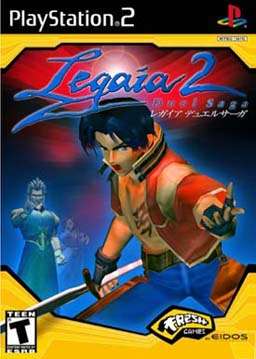Legaia 2: Duel Saga
| Legaia 2: Duel Saga | |
|---|---|
 | |
| Developer(s) | Prokion |
| Publisher(s) | |
| Director(s) | Natsumi Arisawa |
| Producer(s) | Katsuhiko Kanazawa |
| Designer(s) | Takuya Kuwazono |
| Programmer(s) | Noriyuki Watanabe |
| Artist(s) | Natsumi Arisawa |
| Writer(s) | Kazushige Inaba |
| Composer(s) |
Hitoshi Sakimoto Yasunori Mitsuda Michiru Oshima |
| Platform(s) | PlayStation 2 |
| Release | |
| Genre(s) | Adventure, Role-playing |
| Mode(s) | Single-player |
Legaia 2: Duel Saga, known as Legaia: Duel Saga (レガイア デュエルサーガ) in Japan, is a PlayStation 2 action role-playing game developed by Prokion and published by Sony Computer Entertainment. It is the sequel to PlayStation's Legend of Legaia. It was first released in Japan in 2001, and was released in North America and Europe by Eidos Interactive under the label of Fresh Games.[1]
Gameplay
The player controls five characters for the world and only three for the battle screen, while others cannot replace the leading character. The player can learn about each of them as the game progresses. For the campfire, the player can combine meal recipes, and only two or more items to increase status on weapons, armor and accessories. This can be used to create items for special abilities. For the player, each characters can make their own nicknames. The game features a large amount of mini games, quests and optional challenges, such as the guild for every quests, the casino at paradise isle Phorchoon, and for Lang to plant rice and side-jump. In the Centurion Challenge and Battle Arena, hidden bosses appear like the original ones. Like the first game, the player can input four button commands for the "Tactical Arts System". Combining each from three to seven blocks sometimes unlock moves called "Arts", which are permanently available between on the battle and menu screen. The max limited number of art blocks is increased each after leveling up. Several types of moves include Normal Arts (less damage to gain AP), and Super and Hyper Arts (costing AP for more damage). Starting from five blocks for the rest of each characters (except Maya), the player can link with arts in each blocks from hyper to normal and super ones. Mystic Arts are combinations of the character's spiritual powers. It costs 100 AP and MP, and each characters must have 50% or less of HP and seven blocks. Variable Arts are double team moves that two characters perform to defeat one enemy, using six blocks and costing 80 AP. The player can use the power of the spirits, costing MP to increase their status temporarily, recover health, and annihilate one or all enemies.
Plot
Setting
The game follows a group of outcasts called "Mystics", siding to fight each other between good and evil, and the people believe in. The Mystics summon natural spirits called "Origin". They were created by the Source Forge, the world's creation located inside Demiurge Tower, along with three magical stones (Aqualith, Pyrolith and Aerolith). In the town of Kravia, mystics went on a rampage, leaving the crater as a trace. Under the castle sewers of Darakin connects to the underground cave of Kabel, the abandoned kingdom.
Characters
The main protagonist is Lang, the village swordsman, one of the star shapers and owner of fire origin Galea. Maya, an orphaned magician and owner of life origin Rivas, lost control of her powers and voice, but manages to recover all. Elder martial arts teacher Kazan, the owner of earth origin Deva, whose ex-student and swordsman, Rauss, fails to resist the power of forbidden arts with his body. Female pirate captain and Alphis' daughter Sharon Blade, the owner of thunder origin Arrode. Spiritual giant Ayne (Silent Eagle), one of the tribe members living in the hill island of Jinga. The main villain is Avalon, one of the star shapers and owner of the supreme origin Igohl. As one of the survivors, he upsets the people for killing the rest of all mystics. Avalon separates the stones and scatter each on each locations to disable the Source Forge. He works with the sorceress Velna (owner of Vestra), Darakin's bishop Doplin, and foster siblings Elliot and Marienne (owners of Raskia and Alvadis).
Story
Lang lives to work between in the village and the forest, until Avalon takes the Aqualith. Lang gets imprisoned, but escapes from the citadel and awakens Galea inside of him. After Lang brings the Aqualith back to the village, the black sun appears and it causes apocalypse. The party learns from tree spirit Reym that Avalon attempts to change the world. When Lang takes the Aqualith, the heroes retrieve the Pyrolith from the volcanic isle of Drokonia and the Aerolith from the sky tower of Ellsworth. As they place all stones back to the Source Forge, Lang obtains the water fragment of hope. With the sun restored, Lang declares that everyone in the world are having the "will to live".
Reception
| Reception | ||||||||
|---|---|---|---|---|---|---|---|---|
| ||||||||
The game received an average score of 70.46% at GameRankings, based on an aggregate of 40 reviews[2] and an average score of 67/100 at Metacritic, based on an aggregate of 21 reviews,[3] and was much less successful than its predecessor. According to Famitsu sales information, the game sold 40,302 during its debut week in Japan, ranking sixth among all new releases for that period.[4] It barely made it into Dengeki Online's top 200 best-selling games of 2001 with 53,808 copies.[5]
References
- ↑ GZ Interview: Prokions president talks about the innovations brought to the Legaia continent in Legaia 2 Duel Saga
- 1 2 "Legaia 2: Duel Saga". GameRankings. Retrieved 2011-10-24.
- 1 2 "Legaia 2: Duel Saga". Metacritic. Retrieved 2011-10-24.
- ↑ IGN staff (December 7, 2001). "The Famitsu Top 10 (11/26/01 - 12/02/01)". IGN. Retrieved May 2, 2012.
- ↑ IGN staff (January 11, 2002). "Dengeki Online Top 200 Of 2001". IGN. Retrieved May 2, 2012.